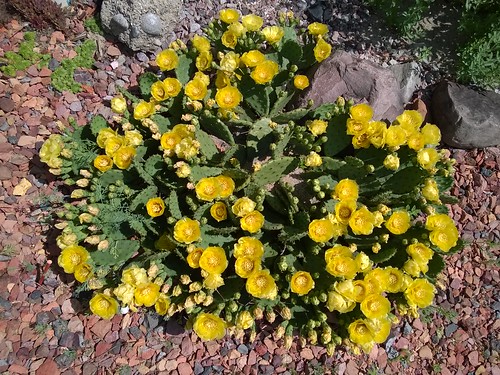For folks who have purchased some pads of the prickly pears from me at the annual show and sale, here are some photos of some of these plants in the garden and in nature, and also a link to the USDA plant profile.
Opuntia fragilis:
http://plants.usda.gov/core/profile?symbol=OPFR
Opuntia humifusa:
http://plants.usda.gov/core/profile?symbol=OPHU
Opuntia phaeacantha:
http://plants.usda.gov/core/profile?symbol=OPPH
From the flyer:
Prickly pear cacti may be offered as pads, and that’s what these are. This cactus needs to be planted in a certain way: it needs to be rooted. I root my prickly pear cactus by laying the pad on the ground the way a dish sits on a table, but a little more on an angle (like a saucer or plate tipped slightly on one edge). The edge that I tip toward the ground is always the base or narrowest part of the pad, where the pad was cut off the main plant. I ensure that edge tipped down to the ground has good contact with the ground (soil, not rocks) and that it is never allowed to remain damp or soggy for any length of time. I never bury the pads much. Finally, I ensure that the pads don’t grow legs and walk off — I keep the part tipped to the ground using a wire coat hanger bent in a U-shape and stuck in the ground.
Well-drained soil is what these cacti are used to. These particular cacti are growing outdoors in sandy loam, sand + gravel, or potting soil + lots of perlite. They are grown in the full sun (south and west sides of the house) and not anywhere where water can pool, nor where the soil is soggy.
I plant them anywhere between April and early October. On occasion, I have stored some of my prickly pear pads indoors in a dry, cool, dark place over the winter when I could not plant them by October. But all these pads for sale were freshly cut within the last two weeks.

![OF1 - 2011-MAY - Opuntia fragilis "HF" [Minnesota] - (Michigan)](https://live.staticflickr.com/2557/5753766640_59f129d22c.jpg)

![OPh1 - 2011-JUN - 17001-(1) Opuntia phaeacantha DJF970.18 [Canada] - (Michigan)](https://live.staticflickr.com/6060/5910613111_8cb6d6c3d3.jpg)